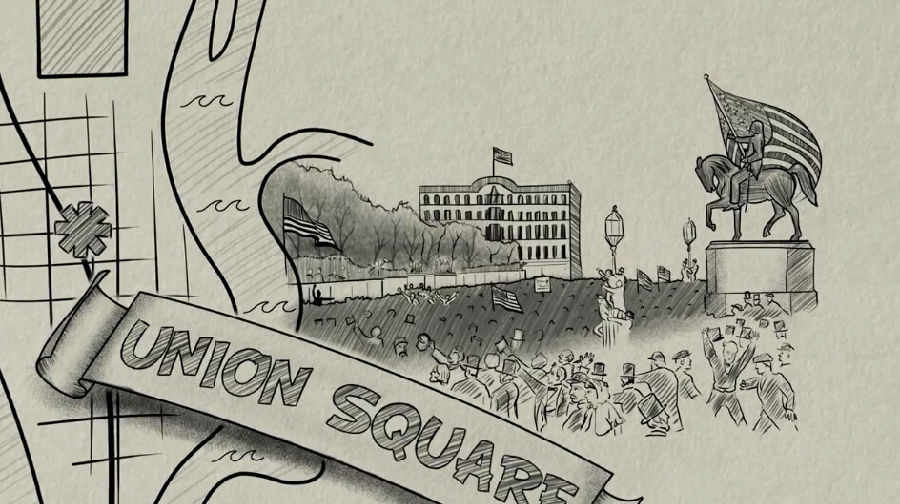Why Do Americans and Canadians Celebrate Labor Day?
How's this for a strange idea: a day off from work in honor of work itself? Actually, that is what Labor Day (celebrated in the United States and Canada on the first Monday of every September) is all about.
這樣一個怪點子如何:從工作中放一天假來紀念工作本身?事實上,那就是勞動節(jié)(在美國和加拿大是每年九月的第一個星期一慶祝) 那就是勞動節(jié)的意義。
The first American Labor Day was celebrated in New York City on September 5, 1882, as thousands of workers and their families came to Union Square for a day in the park. It was not a national holiday, but had been organized by a union to honor workers and their hard efforts with a rare day of rest—halfway between July 4 and Thanksgiving. There were picnics and a parade, but there were also protests. The workers had gathered not just to rest and celebrate, but to demand fair wages, the end of child labor, and the right to organize into unions.
第一個美國勞動節(jié)是于 1882 年 9 月 5 日在紐約市慶祝,數(shù)千民勞工和他們的家人到聯(lián)合廣場在公園度過一天。那并不是個國定假日,但由工會安排來用一天難得的休假感念工人以及他們的辛勞--在 7 月 4 日和感恩節(jié)之間舉行。有野餐和游行,但也有抗議活動。工人們不只聚集來休憩和慶祝,也聚集來要求合理工資、童工的終結(jié),以及組織工會的權(quán)利。
During the period known as the Industrial Revolution, many jobs were difficult, dirty, and dangerous. People worked for 12 hours, six days a week, without fringe benefits such as vacations, healthcare, and pensions. And if you were young, chances are you were doing manual labor instead of your ABCs and fractions. Children as young as 10 worked in some of the most hazardous places, like coal mines, or factories filled with boiling vats or dangerous machines.
在被稱為“工業(yè)革命”的時期,許多工作都是艱辛、骯臟且危險的。人們一周工作六天,一天工作十二小時,沒有任何額外福利,例如休假、健保,以及退休金。如果你年紀小,可能你那時是在做苦工而不是在上 ABC 跟算數(shù)學(xué)分數(shù)。十歲那樣年紀的孩子在一些最危險的場所內(nèi)工作,像是礦坑,或是充滿滾燙大缸或危險機器的工廠。

Trying to win better pay, shorter hours, and safer conditions, workers had begun to form labor unions in America and Canada. But the companies they worked for often fought hard to keep unions out and to suppress strikes. At times, this led to violent battles between workers and business owners, with the owners often backed up by the police, or even the military.
試著爭取更好的工資、更短的工時,以及更安全的工作環(huán)境,工人們開始在美國和加拿大內(nèi)組織工會。但他們效力的公司常激烈抵抗,以將工會屏除在外以及壓制罷工。時不時地,這引起工人和老板間火爆的沖突,老板們往往有警方或甚至軍方撐腰。
In the following years, the idea of Labor Day caught on in America, with official celebrations reaching 30 states. But then came the violent Haymarket Square Riot of 1886, which led to the deaths of several policemen and workers in Chicago and the execution of four union leaders. After that, many labor and political groups around the world had begun to mark Haymarket Square on May 1, which became known as International Worker's Day.
接下來幾年內(nèi),勞動節(jié)的理念在美國盛行,正式慶祝活動延伸到三十個州。 但接著發(fā)生了 1886 年激烈的干草市場廣場暴動,那導(dǎo)致芝加哥數(shù)名警員和工人的死亡,以及四位工會領(lǐng)袖的處決。在那之后,全世界許多勞工和政治團體開始在五月一日標上干草市場廣場,那天后來變成以國際勞動節(jié)著稱。
In 1894, President Grover Cleverland signed the law, making Labor Day a federal holiday in America, only days after he had sent 12,000 soldiers to end a violent railroad strike that resulted in the death of several people. The original September date was kept, partly to avoid the more radical associations of May 1.
1894 年,格羅弗·克里夫蘭總統(tǒng)簽署法條,使勞動節(jié)在美國成為一個聯(lián)邦法定假日,僅僅在他派出一萬兩千名士兵去結(jié)束一場造成數(shù)人身亡的鐵路罷工后。原先九月的勞動節(jié)日期被保留著,部分是為了避免關(guān)于五月一號那較激進的聯(lián)想。
Canada also created its Labor Day in 1894. But in spite of this new holiday, it would be a long time before the changes that workers wanted became a reality.
加拿大也在 1894 年設(shè)立了自己的勞動節(jié)。但盡管有這新的節(jié)日,在工人們想要的改變成真之前,仍距離一段很長的時間。
In 1938, during the Great Depression that left millions without jobs, President Franklin D. Roosevelt signed a law, calling for an eight-hour workday, a five-day workweek, and an end to child labor—some of the first federal protections for American workers.
1938 年,在使數(shù)百萬人失業(yè)的經(jīng)濟大蕭條期間,富蘭克林·D·羅斯福總統(tǒng)簽下一個法案,要求八小時的工作天、五天的工作周,以及童工的終結(jié)--一些對美國勞工最早期的聯(lián)邦保護法案。
As America and Canada celebrate Labor Day, most of the two countries' children enjoy a day off from school. But it is important to remember that there was a time that every day was a labor day for children in America and Canada. And unfortunately, the same fact remains true for millions of children around the world today.
在美國和加拿大慶祝勞動節(jié)時,這兩國的孩子們大多都在享受一天不用上學(xué)的假日。但很重要的是要記得,曾有段時光美國和加拿大的孩子天天都是勞動日。而不幸地是,相同狀況在今日全球數(shù)百萬名孩童身上仍是真實的。












